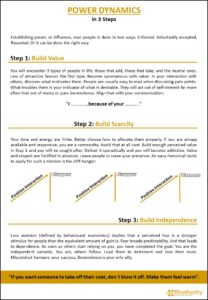Power Dynamics in 3 Steps: Influence Without Resistance
Power and influence over people can be established in two ways. One is forced—reluctantly accepted, resented, and destined for resistance. The other? It flows naturally, drawing people in without coercion.
Mastering power dynamics is not about control. It’s about becoming the gravitational force people willingly orbit. Here’s how to do it in three steps:
Step 1: Build Value
Every person you meet falls into one of three categories:
- Givers – They add value to others.
- Takers – They drain energy and resources.
- Neutrals – They remain uninvolved.
The law of attraction favors the first type. If you want influence, you must become synonymous with value.
How to Build Value
People act out of self-interest far more often than out of mercy or pure benevolence. They follow those who solve their problems, not those who demand attention.
Your task is simple: identify what troubles them. Pain points reveal motivation. The more accurately you diagnose their concerns, the more indispensable you become. Align your communication with their needs, and they will naturally gravitate toward you.
Once value is established, scarcity must follow.
Step 2: Build Scarcity
Your time and energy are finite. Treat them as such.
If you are always available, you become a commodity—easily obtained, easily discarded. The more accessible you are, the less people respect your presence. To cultivate true influence, you must master the art of controlled absence.
How to Build Scarcity
- Create Perceived Rarity – When you deliver value sporadically, you become addictive. People chase what they cannot have.
- Use Strategic Absence – Step back at the right moment. This fortifies value and respect.
- Leverage the Cliffhanger Effect – Leave conversations at their peak. Make people anticipate your return.
Scarcity does not mean withholding value entirely. It means giving just enough to make them crave more.
Step 3: Build Independence
True power is not in control—it is in being the independent variable in any equation. You act, others react.
The Role of Loss Aversion
Behavioral economics teaches us a powerful lesson: people fear losing something more than they desire gaining something of equal value. Fear breeds predictability, and predictability creates dependence.
Once others begin relying on you, your influence is complete. However, power comes with responsibility. Misuse it, and you destroy everything you have built.
How to Build Dependence Without Resentment
- Be the Source of Solutions – When people turn to you first, you are indispensable.
- Lead, But Never Exploit – Influence must be wielded with care. The moment people sense manipulation, they retreat.
- Use Benevolence, Not Force – Power should be welcomed, not imposed.
“If you want someone to take off their coat, don’t blow it off. Make them feel warm.”

